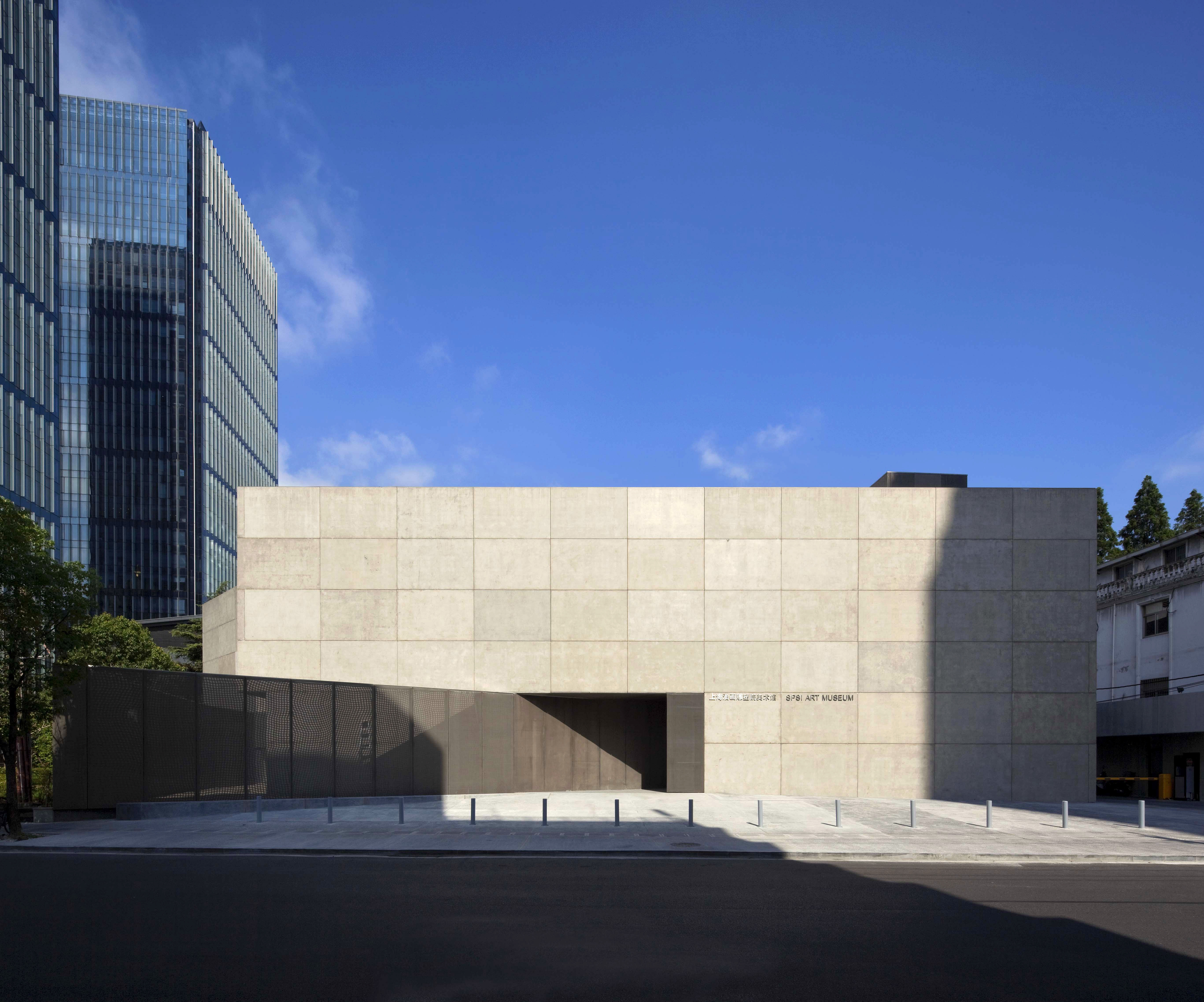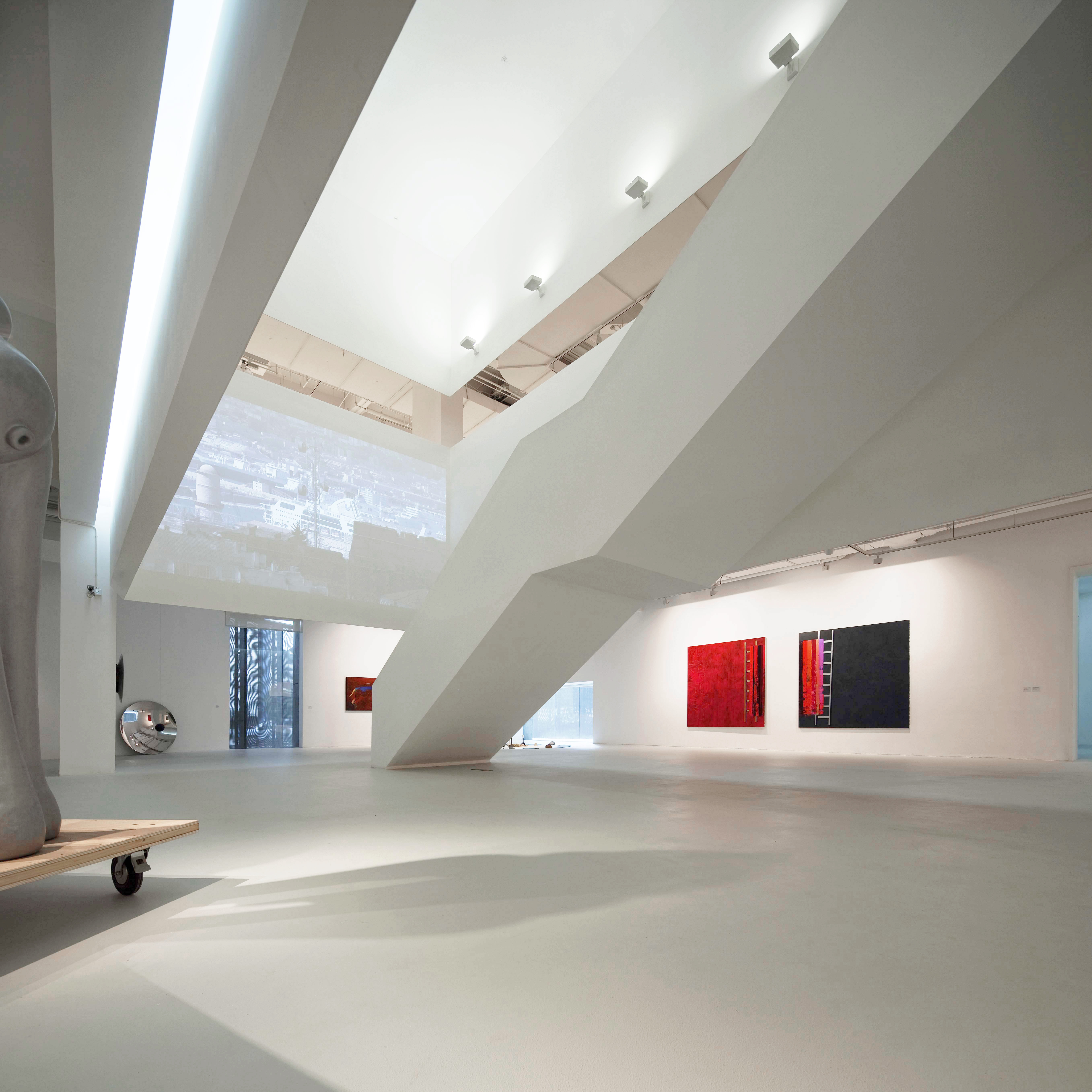上海油雕院美术馆位于上海市长宁区金珠路111号,在油雕院原有物业大楼结构基础上扩建完成。美术馆设计完全由建筑本身出发,在回答建筑基本问题的过程中,逐渐接近答案。建筑本身的体量、空间、材质、构造展现出了一种质朴纯净的力量。
新馆设计主张重视道路空间界面的完整,填补缺失,建筑明确地平行于街道;并且取消沿街围墙,留出尺度适宜的开放的公共入口广场。美术馆如一块被切割成几何多边形的坚硬石块横卧于金珠路旁,它沉稳而棱角分明,简洁而厚重有力的体量让人们从相邻建筑的装饰化立面感受中解脱出来。不锈钢编织网围墙折向延伸,顺势直接斜插入建筑主体,巧妙地形成了入口空间,同时围合了一个内院,为接待厅提供了室外景观。
对于室内来说,平滑的墙面围合纯净的室内空间,对于城市来说,平滑的外墙限定了明确的室外空间,去掉一切不必要的装饰,最大限度地营造出干净的空间体验,同时也突出了艺术作品本身。
楼梯空间仿佛是反扣的长方形光罩,从建筑顶部垂直向下生长,楼梯轻盈落地,在地面仅有一个支撑点,它的形体本身就如同一件现代雕塑作品。我们特意将扶手的剖面设计成45度尖角向上的形式,这样从内部看来,光罩给人的体量感受很薄很轻,就像是用纸折叠出来的。当厚度消失,抽象的面的感受就出现了。
我们坚持选择了预制混凝土挂板作为墙面材料。混凝土板由于浇注条件的细微差别,呈现出随机的色差与不尽相同的模板肌理,显得自然而生动。同时板表面的防护剂也是应对城市恶劣大气条件对建筑立面腐蚀和污染的有效手段。每块混凝土板近3米宽2米高,大尺度营造出公共开放的建筑气质。转角处采用犬牙交错的累叠方式,让材料有了厚度以及明晰的构造,建筑也显得更加厚重。斜墙不锈钢编织网板与混凝土板色泽接近却非常细腻,在阳光下有着金属反光的质感。而正面观看时却可隐约透过网格间洞悉到背后的事物,像一层薄纱般轻曼灵动,与混凝土浑厚的实体感觉形成鲜明的对比,却又在整体上相互协调统一。
立面干挂混凝土网格分缝“投影”在入口广场水刷石地面上,形成由1厘米宽不锈钢分割条编织的网格,网格大小与立面分缝尺寸相仿,并像影子一样在平立面交接处精确对位;不锈钢网格顺着地面的坡度转折而略有起伏,造成细微动感。当网格延伸至斜墙前50厘米高的矮墙时,不锈钢条按照几何投影的规律“爬”过,直至隐没。严谨的对位关系使不同建筑材料间的构造关系变得密切,建筑成为有着统一营造逻辑关系的整体,各部分彼此间不可分割。
整个建筑设计语言与构思完全从建造场所以及建筑本身出发,摒弃诸如影像、信息、社会、心理等其他相关学科理念主导建筑设计理念的设计方法。在很多建筑师试图跨界寻求设计答案的时候,我们仍然坚信建筑自身语言魅力足够打动人的心灵。
SPSI Art Museum is located at Shanghai Changning District, No.111 Jinzhu Road, extended from the structure of original service building of Shanghai Oil Painting & Sculpture Institute.
On 19th October 2010, the museum has finished its construction and had the first exhibition.—- Modern Art Works Marsaille.
The thinking of architectural design of SPSI Art Museum is to start from environment and architecture itself, and to find the result during the process of answering the basic architectural questions. The final result even surprised our-selves. The effect of its volume, space, material and structure has touched us deeply, which turns out to be a kind of pure power.
Design of new Art Museum has set up clear volume parallel to the street and cancelled the fences, in order to create complete open entrance space between the city and building, which is much more reachable and public.
Like a polygon form stone lies the Museum along Jinzhu Road, calm and angular, simple but powerful, which rescues people from decorating facade of neighborhood. The wall between Museum and its neighbor East Center had to be remained. A piece of alone standing wall cannot form the feeling of volume, which is uncoordinated to the Museum main volume. We decide to continue the wall back into the main body of Museum, so that it creates a impressive entrance space and at the same time a nice inside garden, which supplies good view for the VIP room on the first floor.
Smoother the surfaces are, clearer the volume become and purer the space appear. To the interior, smooth wall inside-surfaces create pure interior space, while to the city, smooth wall outside-surfaces definite clear open spaces. So we abandon all decoration on both sides of wall, try to create the atmosphere of pure spaces, in order to highlight the art works at the same time.
The stair space looks like a long square form cover hanging from the ceiling. It is regarded as a natural part of interior building structure growing down from above. Stairs flies down directly on the ground, without any other structure support, which makes itself look like a piece of sculpture work.
The top of handrail has been designed as a 45 degree tri-angle form, in order to minimize the width of the cover, which make it looks very light, as if the cover is made of paper. The feeling of an abstract surface appears when the width disappears.
we finally choose the concrete as the facade material. Due to the tiny difference of the conditions when every piece produced, the color and texture of each piece appear different, look like stones, natural and live.
The protective agent on the concrete panel surface protect the concrete against the corrosion of sour rain or climate atmosphere. Every concrete panel is round 3 meters long 2 meters high, has a kind of public temperament. At the building corner, L-form panel stack above each other like jigsaw, which make the whole volume look heavier and stronger.
The color of stainless steel panel seems coordinated with the concrete wall, and has a little metal reflection effect under the sunlight. From the front people can observe the things behind ambiguously. The light thin transparent texture feeling contrasts to the heavy thick solid character of concrete panel very much, but seem coordinated to both.
The grid of concrete panel curtain wall cast on the water-brushed stone ground, in order to form a grid net of 1 cm bride stainless steel. The size of both of grids are similar, exactly meet each other at the corner of ground and facade, just like shadow following its volume; the grid of stainless steel follows the slope of the ground, up and down. When it hits the 50 cm high low-wall, it just climbs over like the shadow. The severe construction relationship of different materials has united different elements as one body under the same construction logic, each of it cannot be separated.
The whole design work starts totally from location and the concrete conditions of the building itself, abandoning the design method derived from other relative subjects such as imaging, informatics, sociology, psychology etc. Today, when many architects seeking answer by studying other subject, we still stick on the architectural thinking itself and believe that it is already charming enough.
业主 Client
上海油雕院美术馆
所在地址 Location
上海市长宁区 Changning, Shanghai
建筑规模 GFA
3,000㎡
项目类型 Type
文化&教育、城市更新
设计范围 Design scope
建筑、室内
设计周期 Design period
2008 - 2010





